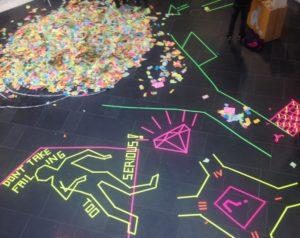Read on for insights from the d.confestival and d.safari in September 2017 on how design thinking can be brought to large companies.
Greetings from the d.confestival and d.safari, a mix of a design thinking conference and festival celebrating the 10th birthday of the d.school Hasso Plattner Insitute in Potsdam, Germany. This has gathered design thinking academics and practitioners around the globe together to discuss everything from design thinking and neuroscience to social innovations. I would like to share some of the experiences of trying design thinking relayed from the very largest companies, exceeding most Finnish cities in size.
 Container muse as a first step at Daimler (284 000+ employees): To help turn both management and employees to fans of design thinking, Daniel Biederman describes bringing in a design thinking container and first batch of design thinking coaches in the middle of a plant to give first-hand experiences in design thinking. A bit over a year into the process, they’ve package design thinking into a step-wise process to help employees have faith that a result will wait at the end.
Container muse as a first step at Daimler (284 000+ employees): To help turn both management and employees to fans of design thinking, Daniel Biederman describes bringing in a design thinking container and first batch of design thinking coaches in the middle of a plant to give first-hand experiences in design thinking. A bit over a year into the process, they’ve package design thinking into a step-wise process to help employees have faith that a result will wait at the end.
Moving on to consulting internal teams at Phillips (114 000+ employees): Maarten Rincker shared moving on from design thinking training to a dedicated unit helping internal projects in human-centered innovation. Design thinking skills have thus needed to be coupled with consulting and project management expertise to be able to create successful end-results, not just good ideas.
Bringing design thinking to the customers at SAP (84 000+ employees): Similarly Andreas Hauser reports that while SAP has trained thousands of employees in design thinking, he’s more excited about the 600+ customer design engagement that have been completed after SAP began offering design thinking to its clients and partners. They use design thinking to make sure their doing the right thing, and agile to effectively deliver it.
Employees self-organizing at Bosch (390 000+ employees): Uwe Raschke shared the journey of the Home and Garden business unit giving organizational design to the collective hands of the employees last year. As a result, different departments relocated to a shared building, organizing cross-functionally around application areas, eliminating two out of six hierarchical levels, and incentives were transformed from the individual to team-level performance. They are now experimenting with increasing transparency by opening up high-level meetings so that any employee can tune in.
One underlying theme: communication
The importance of communication was highlighted in all of the different forms of efforts. Daimler and Phillips, just some years into bringing design thinking to the organization, emphasized the need to get showcases to concretize the added value design thinking can bring. Looking back at already a decade of efforts, Sam Yen from SAP and Angela Haas from Swisscom/Creaholic both described scaling design thinking in their organizations as a bumpy ride with ups and downs. Success stories can again help here in recovering from the speed bumps. Andreas Hauser from SAP highlighted tailoring the message to each audience – convincing sales with client deal values, consultants with adoption rates, developers with product improvements, and so on.
In addition to sharing success stories, many highlighted that design thinking needs to be experienced rather than just told of. Both Frederick Pferdt from Google and Uwe Raschke from Bosch highlighted opening up the company’s decision making to everyone in it and the transparency of the top management. So let’s share our development ideas and build on top of them!

 Aalto DF
Aalto DF